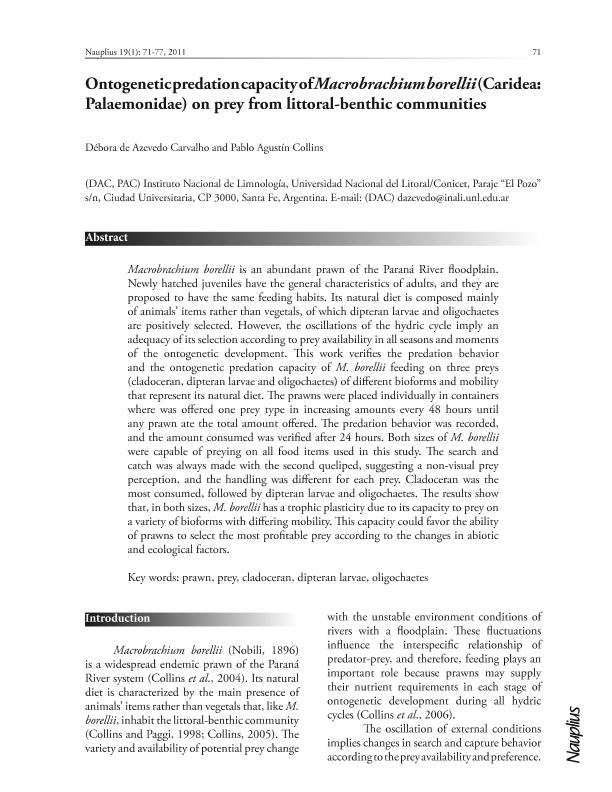Mostrar el registro sencillo del ítem
dc.contributor.author
Carvalho, Dévora de Azevedo
dc.contributor.author
Collins, Pablo Agustin

dc.date.available
2019-05-15T14:33:45Z
dc.date.issued
2011
dc.identifier.citation
Carvalho, Dévora de Azevedo; Collins, Pablo Agustin; Ontogenetic predation capacity of Macrobrachium borellii (Caridea: Palaemonidae) on prey from littoral-benthic communities; Sociedade Brasileira de Carcinologia; Nauplius; 19; 1; 2011; 71-77
dc.identifier.issn
0104-6497
dc.identifier.uri
http://hdl.handle.net/11336/76340
dc.description.abstract
Macrobrachium borellii is an abundant prawn of the Paraná River floodplain. Newly hatched juveniles have the general characteristics of adults, and they are proposed to have the same feeding habits. Its natural diet is composed mainly of animals’ items rather than vegetals, of which dipteran larvae and oligochaetes are positively selected. However, the oscillations of the hydric cycle imply an adequacy of its selection according to prey availability in all seasons and moments
of the ontogenetic development. This work verifies the predation behavior
and the ontogenetic predation capacity of M. borellii feeding on three preys (cladoceran, dipteran larvae and oligochaetes) of different bioforms and mobility that represent its natural diet. The prawns were placed individually in containers where was offered one prey type in increasing amounts every 48 hours until any prawn ate the total amount offered. The predation behavior was recorded, and the amount consumed was verified after 24 hours. Both sizes of M. borellii were capable of preying on all food items used in this study. The search and catch was always made with the second queliped, suggesting a non-visual prey perception, and the handling was different for each prey. Cladoceran was the most consumed, followed by dipteran larvae and oligochaetes. The results show that, in both sizes, M. borellii has a trophic plasticity due to its capacity to prey on a variety of bioforms with differing mobility. This capacity could favor the ability of prawns to select the most profitable prey according to the changes in abiotic and ecological factors.
dc.format
application/pdf
dc.language.iso
eng
dc.publisher
Sociedade Brasileira de Carcinologia
dc.rights
info:eu-repo/semantics/openAccess
dc.rights.uri
https://creativecommons.org/licenses/by-nc-sa/2.5/ar/
dc.subject
Prawn
dc.subject
Prey
dc.subject
Cladoceran
dc.subject
Dipteran Larvae
dc.subject.classification
Otras Ciencias Biológicas

dc.subject.classification
Ciencias Biológicas

dc.subject.classification
CIENCIAS NATURALES Y EXACTAS

dc.title
Ontogenetic predation capacity of Macrobrachium borellii (Caridea: Palaemonidae) on prey from littoral-benthic communities
dc.type
info:eu-repo/semantics/article
dc.type
info:ar-repo/semantics/artículo
dc.type
info:eu-repo/semantics/publishedVersion
dc.date.updated
2019-05-07T20:25:34Z
dc.identifier.eissn
2358-2936
dc.journal.volume
19
dc.journal.number
1
dc.journal.pagination
71-77
dc.journal.pais
Brasil

dc.journal.ciudad
Rio Grande Sul
dc.description.fil
Fil: Carvalho, Dévora de Azevedo. Consejo Nacional de Investigaciones Científicas y Técnicas. Centro Científico Tecnológico Conicet - Santa Fe. Instituto Nacional de Limnología. Universidad Nacional del Litoral. Instituto Nacional de Limnología; Argentina
dc.description.fil
Fil: Collins, Pablo Agustin. Consejo Nacional de Investigaciones Científicas y Técnicas. Centro Científico Tecnológico Conicet - Santa Fe. Instituto Nacional de Limnología. Universidad Nacional del Litoral. Instituto Nacional de Limnología; Argentina
dc.journal.title
Nauplius

dc.relation.alternativeid
info:eu-repo/semantics/altIdentifier/url/http://www.scielo.br/scielo.php?pid=S0104-64972011000100008&script=sci_abstract&tlng=en
dc.relation.alternativeid
info:eu-repo/semantics/altIdentifier/doi/http://dx.doi.org/10.1590/S0104-64972011000100008
Archivos asociados
